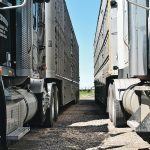Ag committee identifies emergency management and hours of service as main concerns with proposed regulations
Truck drivers can legally exceed their regulated hours if it’s an emergency, but when does animal welfare meet that description? That was among the topics tackled as the House of Commons agriculture committee released its report on challenges facing the livestock transport sector. The report, Striking a Balance: Electronic Logging Device Requirements Impacting Animal Transportation, […] Read moreTag Archives livestock transport

New livestock trucking regulations a concern
FORT MACLEOD, Alta. — Aspects of the new federal livestock transportation regulations, scheduled to take effect Feb. 20, continue to concern the cattle industry. The Canadian Cattlemen’s Association has asked the Agriculture Canada to delay enforcement of the new rules for two years so the results of livestock transport research still underway can be incorporated […] Read more

Work on codes of practice receive funding
Feds contribute $4.56 million to update codes for livestock transport, dairy cattle and goats and write a new one for fish
National codes of practice for livestock transport, dairy cattle, goats and fin fish can progress this year because of a $4.56 million funding announcement from the federal government. Agriculture Minister Lawrence MacAulay announced the funds Feb. 19, which will be provided to the Canadian Animal Health Coalition on behalf of the National Farm Animal Care […] Read more
Transport times a major issue
Some of the proposed changes to Canada’s livestock transport regulations don’t sit well with the Livestock Markets Association of Canada. The group represents livestock auction market owners across Canada and many of the changes proposed by the Canadian Food Inspection Agency will directly affect them. “It will affect a lot of the way that we […] Read more

Animal transport regulations updated
Shorter times in transit for livestock are among the proposals in new regulations posted for public comment Dec. 3 by the Canadian Food Inspection Agency. About 700 million animals are transported each year, a figure that includes mostly poultry but also cattle, pigs, horses, sheep and goats. The CFIA said in background information accompanying the […] Read more

Culled dairy cows can face tough journey
Long distances to plants and delays in timely culling by farmers are blamed for problems; nine-point plan developed
OTTAWA — Management of cull dairy cows must be improved, according to a study undertaken by PhD student Yanne Jane Stojkov of the University of British Columbia. About 350,000 dairy cows a year are designated for slaughter in Canada, and some of them face long journeys to processing plants despite having health issues including lameness […] Read more
Fatigued animals a concern for producers
Muscle trauma, fatigue can cause animals to be unable to stand or walk after transport to slaughter plants
MANHATTAN, Kan. — The livestock industry is starting to pay more attention to the issue of fatigued animals arriving at slaughter plants. “Mobility of cattle at slaughter facilities has gained a lot of focus over the last few years,” said Jacob Hagenmaier, a veterinarian and PhD candidate at Kansas State University. Some have suggested over-use […] Read more





